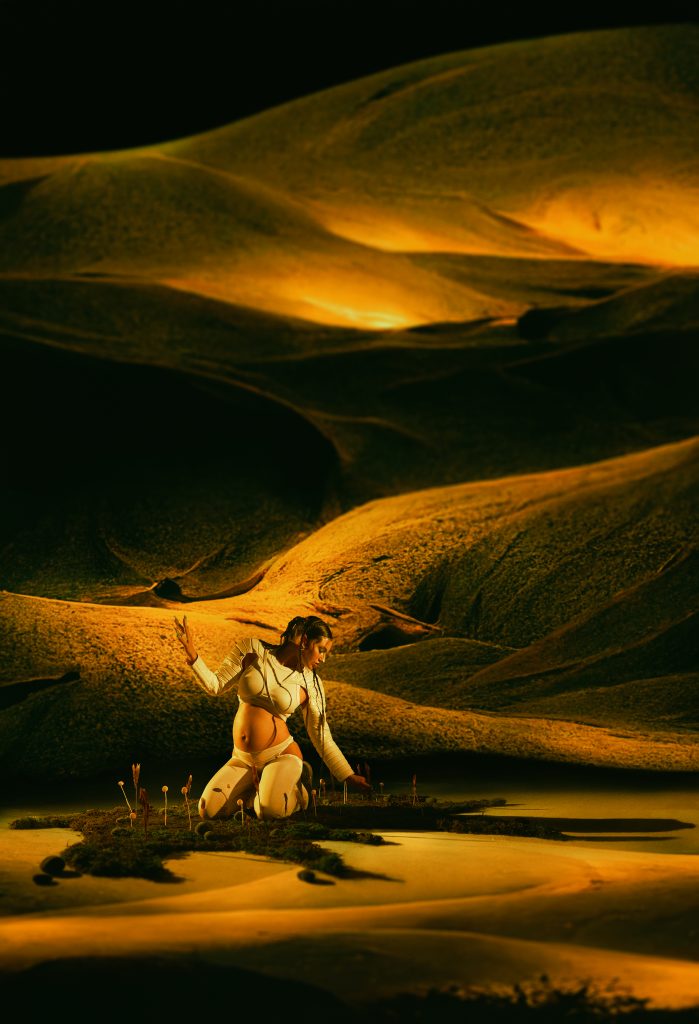This essay appears in print in PALLADIUM 07: Garden Planet. To receive your copy of Palladium’s quarterly print edition, subscribe here.
It is now 2053. The ducted fans roar as your taxi drone comes in for landing on a near-ballistic trajectory. The G-forces take some getting used to, but no one in a hurry uses surface cars anymore; too hard to automate, too slow, and too constrained by the built environment. Better to jump.
You spot her waiting there on the far side of the rooftop garden as the door pops open. The recharge cable robot shuffles out of your way as you step out of the craft and off the jump pad. You start winding along the mossy paths between sword ferns and flowering trees. The bees whiz by on their rounds. The new government palaces all have these lush wildlife gardens, laid out for socializing and contemplation. It’s the perfect spot to meet an important citizen.
You were worried about meeting outside on such a hot day, but the garden is moist and comfortably shaded. The building’s cloud generator emulates the microclimate of the local valleys when the fog rolls in.
Using this much water and power would have been considered an environmental atrocity just 20 years ago, but those worries have mostly disappeared in a flood of cheap electricity. Now, it’s more important for the government to demonstrate its power to sustain life in a damaged world. The birds flitting overhead seem to appreciate the change.
The nuclear renaissance has been one of the most important development programs of the new government. None of this would be possible without it. Your contact was a key spokeswoman for that change. She had pulled strings and built momentum until the program vision came together, and then made her empire on getting it done.
Entrepreneurial statecraft: exactly the kind of work your own ambitions have led you to.
With your recent successes lining up, you’ve finally gotten a chance to sit down with her and get the full story. She smiles and welcomes you, and beckons to a bench beneath a tree. You sit down and break the ice with small talk. When you’ve both settled in, your digital assistant asks if you’d like to record a transcript of the conversation. You give the order and dive right into the interview:
One of the most effective ways to create the future is to occupy it and work backward. How did we get here? So if we’re sitting in 2053 planning the rest of the century, it’s helpful to look back at the nuclear renaissance as an example of how these things can happen. What were the key trends and efforts that got nuclear development going again?

As with any big societal shift, you cannot pinpoint a single moment
that defined the future. But there were important markers and events that made it possible for the nuclear renaissance to finally take place. The war between Ukraine and Russia in 2022 was one of the most significant ones, with the West realizing (yet again) the importance of energy independence. Western Europe had made itself dependent on Russian natural gas in the preceding decades and paid the price. Energy shortages during a brutal winter and the reopening of long-gone coal plants, which increased air pollution and worsened climate change, were just some of the consequences. The silver lining was that it became very clear that, for all the posturing, a drastic reduction in energy consumption was not on the table for most of the world. Although it once sounded poetic, in practice lowering energy consumption meant stunting development in the Global South and reversing it in the Global North. Human life had improved dramatically with things like home heaters, cars, and cell phones. So of course when given the choice between deadly coal or no power, we chose coal every time.
The war and subsequent energy crisis also highlighted the deeply ideological politics and hypocrisy of countries like Germany. For decades, German politicians preached about clean energy and climate change. But when the time came to make a decision, those in power chose to close their carbon-free nuclear plants, while bringing back already- closed, highly-polluting coal plants. In that moment, it became clear that anti-nuclear energy sentiment was not only deeply irrational. Most importantly, it was deadly.

This realization opened a window that allowed the new generation
to reassess long-held beliefs about nuclear power. A massive cultural shift began. At first, it began with thousands of people protesting the early closure of existing nuclear power plants in the United States and Europe. Then environmental organizations that had previously maintained a strictly anti-nuclear position started opening up to it. Soon after that, the vast majority of people under the age of 60 had fully embraced the technology, as did enterprising politicians. As theoretical physicist Max Planck said: “A new scientific truth does not triumph by convincing its opponents and making them see the light, but rather because its opponents eventually die and a new generation grows up that is familiar with it.”
Simultaneously, the United States realized that China had been dominating the development, construction, and spread of nuclear power in the developing world, and it decided to step up. It boosted national development of modern nuclear reactors that were smaller, more flexible, and easier to build than previous technology. The U.S. also increased its uranium enrichment capacity and started recycling nuclear waste (spent fuel). All of this made the United States a leader in nuclear energy and allowed the country to fully decarbonize its electricity sector by 2045. Another upside was the leadership in clean hydrogen, water desalination, manufacturing, and direct air capture using nuclear power.
Large-scale changes in policy and industrial investment patterns were required to get nuclear power back on track. In the early twenty-first century, it was hard to imagine how our institutions could have moved on this even if they wanted to. Were the political upheavals in the early twenty-first century a necessary ingredient, or could this have been done regardless?

It could have been done regardless. Unfortunately, during the end of the twentieth and beginning of the twenty-first centuries, most of the West was infected by the meme that nuclear energy was bad. This started in the 1960s with the anti-nuclear weapons movement. Of course, now it’s obvious they’re different technologies with completely different purposes. Environmental organizations made anti-nuclear sentiment the core of their missions and pop culture portrayed the technology as evil. For decades, Western countries bought into the meme and stunted nuclear energy development. However, the countries that kept investing and developing it—China, Russia, South Korea—were successful at deploying the technology at scale in a timely manner and on budget. What we needed was a mindset change and that only came with time, war, and a generational perception shift.
Your career has focused on specifically nuclear power. But life and civilization have always drawn on multiple sources of energy. How do you see the role of other sources like wind, geothermal, and fossil fuels in a clean high-energy civilization?
Energy is the currency of the universe. From relying on human muscles, burning wood, and fossilized plants and animals, to finally splitting the atom, our species has been outstanding due to our ability to use energy to shape everything around us. The more energy we harness, the more we expand our knowledge, technologies, and understanding of the universe. High-speed travel, supercomputing, AI, and space exploration are all only possible because we are able to tap into vast amounts of energy. Nuclear has many advantages over other sources, such as being the most dense, least carbon-intensive, least land-intensive, and one of the least material-intensive. And, let’s be real, it’s the most badass.

However, our ever-expanding need for carbon-free power to not only maintain our civilization, but to also develop new and better technologies, means we need to use every clean energy source available. Solar is an incredible option for California, the southwest of North America, and other desert regions close to the equator. But in northern Europe it doesn’t make nearly as much sense. In the late 2020s, we ramped up the large-scale installation of batteries and solar panels on residential and commercial buildings, and built huge solar farms in those areas. Within a decade, almost every roof was able to collect a solar energy surplus and store the excess in batteries. Countries with incredible hydropower potential like Brazil, Costa Rica, and Norway continued to utilize it to great effect. Same with geothermal and wind. Once we stopped limiting ourselves to a certain technology for arbitrary reasons, we were able to objectively assess all of our options and utilize them where it made the most sense.
One of the biggest concerns for nuclear power was the question of waste. How does it compare to other energy options, and how much of a problem is the waste going to be in the long run?
Looking back, it’s clear that nuclear waste was never as big of an issue as people made it to be. It was especially not an issue when compared to the waste of other forms of energy that were more prevalent at the time, like oil and coal. While spent fuel from nuclear power plants never harmed anyone or polluted the environment, the waste from fossil fuels killed millions of humans, year after year. On top of the direct health impacts, it also caused climate change, which brought our society to crisis.
With nuclear, spent fuel is 96% reusable uranium, so it soon became clear that what we considered waste was in fact a huge amount of untapped energy. Through the 2030s, we started recycling it and developing reactors that could utilize that waste as fuel. The small amount of waste that couldn’t be reused is buried deep in geographically stable locations where it’s safely contained and slowly decaying without harming the environment. These technologies solved the “nuclear waste issue.”
Ironically, the waste from solar panels and wind turbines became a bigger problem for a while. Because of how low-density these energy sources were and their lack of regulation, a large volume of panels and turbines started piling up in landfills. The problem subsided when we forced manufacturers to collect and recycle them properly.

In the early twenty-first century, it looked like solar power at scale was the favored clean energy solution. Why didn’t that work?
It did work, just not in the way that technology purists wanted. Once we gave up on the idea of using solar as the main source of electricity everywhere, or getting some arbitrary percentage of our electricity from it, we opened up the possibility of exploring solutions that made more sense. Massive solar farms that required large amounts of land faced high opposition and protests, especially in light of cheap nuclear electricity. Rooftop solar, which doesn’t require additional land and can power homes and factories directly, prevailed and became predominant in regions of the world where sun is abundant and constant. Wind farms multiplied in the American great plains, Argentina, and Western China. Geothermal is responsible for most electricity production in Iceland and Kenya. Now everyone knows that each region’s electricity matrix is tailored to what makes sense for its resources and potential.
Global warming from carbon emissions used to be a major environmental concern, but the nuclear renaissance has alleviated that. How did nuclear power contribute to solving climate change?
By the 2020s, we began to understand the importance of “firm clean power,” meaning a source of energy that works 24/7 and doesn’t produce carbon dioxide emissions, to balance the grid and achieve decarbonization. That’s different from intermittent renewables like solar and wind which only produce electricity when the sun is shining and wind is blowing, and it’s different from fossil fuels which pollute the atmosphere. Nuclear became the obvious choice because it is the only firm clean power source that isn’t dependent on geography. When public perception changed and most people embraced nuclear, we were able to deploy both renewables and nuclear at a fast pace and phase out fossil fuels for electricity production.
Unfortunately, by the mid-2020s, it became clear that even completely cutting carbon emissions wasn’t enough. We had already pumped so much of it into the atmosphere that the climate had become unstable. We needed active removal to stabilize the climate and prevent continued warming.
Fortunately, abundant nuclear power makes it economical to run direct
air capture machines which suck carbon dioxide straight from the air and sequester it or turn it into useful chemicals. Freshwater scarcity became another big issue in the 2030s, especially with climate fluctuations.
Once again, nuclear came to the rescue by powering energy-intensive water desalination plants with waste heat. Another advantage of splitting atoms to make electricity is that it produces lots of extra heat, which is now used in many places to heat buildings in place of natural gas.
In some ways, the single biggest upstream input to wealth is energy. How has a world of energy abundance impacted global wealth and poverty?

In 2020, there were over 700 million people on Earth without access to any electricity. Today, that number is thought to be closer to 1 million, comprising mostly of uncontacted tribes and those who chose to live without electricity for either religious or philosophical reasons. Nuclearization brought electrification all over the world. Access to electricity has become a choice, not a consequence of your place of birth. That has unleashed a lot of human potential, especially in what used to be considered developing countries. Access to electricity led to higher levels of education, especially amongst young women, which radically improved quality of life throughout the African continent and India.
And that’s just direct access. Abundant, clean energy also means manufacturing is cheaper and less environmentally damaging, so everything is more abundant. It also means fewer compromises with problems like polluting factories. Energy gives humans the ability to solve increasingly complex problems.
Going forward into a high-energy future, what are the most exciting possibilities for the rest of the twenty-first century?
In a world with unlimited access to clean energy, many things that we thought were impossible are becoming a reality. One of these is vertical farming, which is freeing huge swaths of land, decreasing use of pesticides, and making it easy to feed the 10 billion humans now on Earth with high-quality food.
Supercomputers are helping us answer some of the biggest mysteries in science, super-optimize everything we design, and train extremely powerful machine learning systems.
The combination of cheap nuclear electricity with carbon capture and hydrocarbon synthesis technologies is making environmentally sustainable supersonic and even hypersonic travel an everyday reality.
Our Mars colony is largely nuclear-powered, and is getting very close
to permanent self-sufficiency. The further we push out into the darker parts of the solar system the more sense nuclear power makes, especially with nuclear propulsion allowing for faster and faster space travel. Our new Ganymede colony will be entirely nuclear-powered.
With advanced recycling technology enabled by abundant energy, almost all material waste can be fully recycled. There are now multiple successful companies digesting the big twentieth century landfills back into metals, industrial chemicals, and fertile soil.
What was too slow in the history of the nuclear renaissance? What should people in 2022 have been working on to enable a richer future of environmentally sound energy abundance? What were people not seeing?
The petty infighting between proponents of different clean energy sources was a waste of time and delayed the deployment of all different technologies. We were slow to change our regulatory environment, which made nuclear power almost prohibitively expensive in the West for several decades. The widespread implementation of a carbon tax and changes in the licensing process for new reactor designs were the biggest drivers of the nuclear renaissance. We lost so much time debating and discussing nuclear waste while millions of people died from fossil fuel’s waste. It’s easy to see threats, but it was much harder to see the amazing opportunities we were missing. We needed to fully grasp what was at stake, and have more imagination about what we could accomplish and more courage to stand up against irrationality.
The nuclear renaissance has opened a whole new universe of possibilities for our species. A universe of abundance, less environmental damage, and greater human happiness.
Editor’s Note: In 2022, Isabelle Boemeke was a fashion model and nuclear influencer. She founded the Isodope project to promote clean energy from nuclear power. At the time, she could be found on Twitter at @i_sodope_ and Instagram at @isabelleboemeke.
